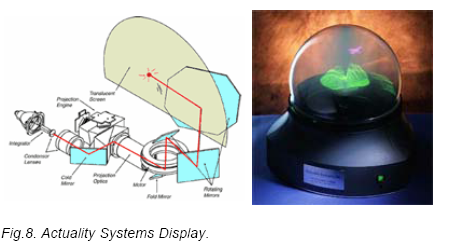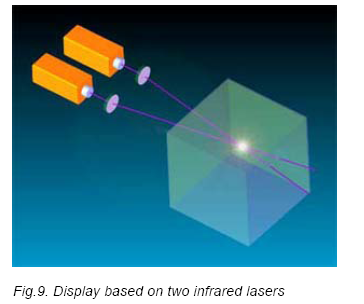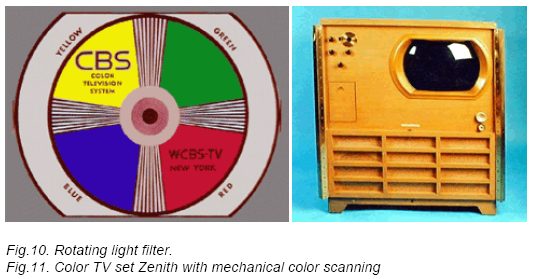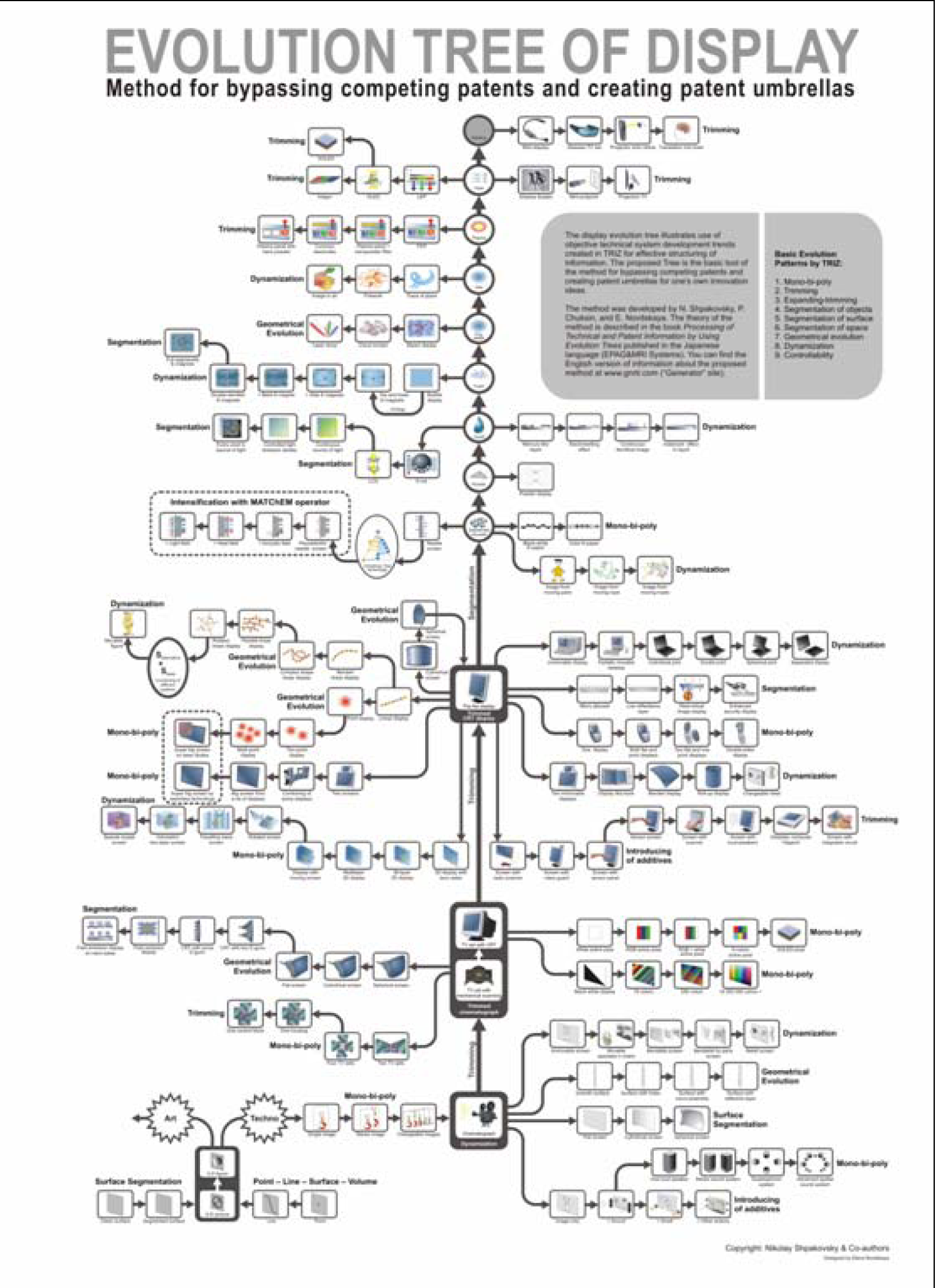Transfer to the microlevel as one of the main display evolution trends
Editor | On 16, Aug 2005
By: N. Shpakovsky
triztrainer@nm.ru
Evolution Trees are among of the main tools of analyzing a technical system and forecasting its evolution which is used for strategic planning. In addition, this approach may be effectively used for by-passing patents of competing companies and constructing patent umbrellas [1,2,3] .
While perfecting the method, we have constructed several Evolution Trees for various technical objects, including the display. Analyzing the display revealed a number of interesting laws which are not always obvious. This article is devoted to one of such laws.
Cinematograph
Cinematograph was the first device for demonstrating moving images on a large screen. This invention is one of the greatest achievements of humankind. Cinema provided huge expressive possibilities for depicting the surrounding world. The cinematograph’s birthday is 28 December 1895. On that day, two Frenchmen – Louis and Auguste Lumiere – organized the first public paid cinema show on the Boulevard of Capuchins in Paris.
Light from a power lamp mounted behind the semitransparent film projects a series of sequentially changing images onto a large screen. Single pictures replace one another rapidly and invisibly to the eye, thereby forming a moving image on the screen.
In addition to the Lumiere brothers, many inventors worked on the projector design including the famous American inventor Edison whose “kinetoscopes” were sold on Broadway in 1894. In Germany, Max Skladanowsky experimented with cinematograph. He made several short films and demonstrated them at Wintergarten theatre (Berlin) in November 1894.
Hannibal Goodwin, the inventor of the celluloid film, Louis Laprence, who invented perforation – four holes on both sides of each frame which is still a standard; William Freeze Greene, the inventor of cinecamera; Birt Acres and Robert Paul, the creators of the projector are among the inventors who contributed to the creation of cinematograph. The Russian inventor I. Timchenko invented one of the most important elements of the cine-projector – the mechanism of intermittent movement of the film which makes cinecameras chirp amusingly.
The principle of operation of the cinematograph remains the same – mechanically drawing a film in front of a light source directed at a screen (Fig.1). It is all the same for the cine-projector whether it is loaded with a black-and-white film or with a color film.
For cine-projector, transfer to the microlevel consists in rejecting the mechanical method of changing the film frames. At present, laser projectors are spreading (Fig.2). Three laser beams – red, green and blue ones – draw an image on a screen. Special mirrors are used to deflect the beams vertically and horizontally.
Black-and-white television
Every technical system tends to become ideal. That is just why such a bulky system as cinematograph was fated for simplification, trimming. The idea of television was as follows. The cinema building is removed from the system while the seats of the audience are moved outside the system. A projector and a screen which were previously spaced apart and not connected with each other are combined into a single compact device which performs image scanning and projecting on a screen.
By analogy with cine-projector, in first television sets, image scanning was performed mechanically, by means of the Nipkov disk [4] . The rotating disk had a number of spirally arranged holes for projecting dots-pixels forming a primitive image on the screen (Fig.3). Then televisions having a cathode-ray tubes appeared. The first scanning cathode-ray tube was invented by the German scientist Karl Ferdinand Braun in 1897 (Fig.4). Cathode-ray tubes were first of all used in oscilloscopes [5] .
The cathode-ray tube had no mechanical parts and image scanning was performed by magnetic deflection of an electron beam generated by an electron gun. The electron beam activated phosphorcoated pixels placed inside the tube on its front panel. In 1932, RCA research laboratory (US) headed by the engineer Vladimir Zvorykin demonstrated the first all-electronic television set. For some time, allelectronic and mechanical television existed in parallel. However, in the middle of the thirtieth, allelectronic television having 180 to 400-line scanning replaced mechanical television having the scanning limit of 30 lines. Thus, transfer to the microlevel occurred, which was unavoidable in the context of technical evolution laws.
3D image displays
3D image displays are gaining popularity today. They may be grouped according to arrangement, principle of operation and image quality. For example, there are displays having a double-layer screen (produced by Deep Video Imaging). There may be more layers (for example, the display of Dynamic Digital Depth). Thus, transfer from the monolayer screen to bi- and polysystems is observed (Fig.5).
This evolution pattern which is known as “Mono-bi-poly” in TRIZ is usually finished with transfer to a monosystem of a higher level. The number of elements in a polysystem cannot grow to infinity. There occurs a contradiction between the system complexity and the realization quality of some of its performance parameters. While designing multilayer 3D displays, the following contradiction arises.
• With many screens-layers, the produced image is deep and 3D, but previous screens overlay successive ones, the image becomes blind and the so-called “rainbow effect” occurs.
• With few screens-layers, previous screens do not strongly overlay successive ones, the image remains high-quality, but not deep enough
This contradiction may be solved by means of dynamization.
Taking one screen and making it move not too rapidly, for example, back and forth, will create the illusion that the screen is always at each point of the volume. Then a luminous dot or several dots appearing according to a special program may be projected on the screen to produce an image (Fig. 6). However, with the reciprocating motion of the screen, huge inertial loads will occur at the direction change points. To eliminate this problem, it is necessary to provide rotary motion of the screen (Fig. 7).
The company Actuality Systems used this principle – rotary motion of a semitransparent screen – to create the first really 3D display (Fig.8). It is a transparent ball having about 50 cm in diameter with a flat 2D display placed inside. The screen rotates at a speed of about ten revolutions per second. Sequential “cuts” of a 3D image are sequentially displayed on it and merge to form a single picture perceived by an observer. A really 3D image is produced. It may be observed from different sides as a real object in space. The display with a rotating screen differs from multilayer displays which produce a pseudo-3D image seen from one side only [6] .
By analogy with the Nipkov disk, the position of dots in space is scanned in the Actuality Systems display by a rotating semitransparent screen, that is, mechanically.
Further direction of the 3D display evolution is transfer to the microlevel. It is necessary to produce a 3D image seen from all sides but without using a rotating disk, only by means of electronic scanning of pixel position.
One of possible solutions is producing luminous dots in crystals or gaseous medium by the action of invisible infrared radiation (Fig. 9).
Beams from two infrared semiconductor lasers cross at a preset point of space filled with active gas. The power of the lasers is selected such that the energy of one beam is insufficient for producing visible light in the gas while the summed energy of the two beams is sufficient to produce a luminous dot. Controlling the deviation of the beams, for example, by means of movable mirrors, it is possible to produce luminous dots throughout the entire gas volume [7] .
Color television
And what about the color television?
By analogy with a cinematograph, black-and-white television and 3D display, the same rotating disk formed by four sector light filters (red, blue, green, and yellow) was used. The disk rotated and overlaid the screen of an ordinary black-and-white television with its edge so that all the four colors sequentially passed in front of it (Fig.10).
The black-and-white display operated according to a special program and four times as rapidly as they usually did. When the red light filter passed in front of the screen, the display showed a red picture. The green filter made corresponding dots green, etc. During a full revolution of the disk, the eye saw four images which fused to form a single color picture. The color TV set Zenith having mechanical color scanning (Fig.11) was manufactured and sold in USA. Transfer to the microlevel occurred very rapidly here and mechanical color scanning was replaced with electronic scanning. Color TV sets were provided with the same cathode-ray tube as black-and-white ones. The only difference was in that they had not one but three electron guns for activating phosphor of a certain color – red, green or blue.
Ideal display
One can see from Table 1 that four different systems – cinematograph, black-and-white TV, color TV and 3D image display – have suffered surprisingly similar transformations. In each case, the mechanical principle of operation was replaced with electronic one and an obvious transfer to the microlevel occurred. This is due to that all these systems are structurally similar, that is, they have the same structure. As is shown in the article by E. Novitskaya [9] , such systems suffer similar transformations during their evolution.
What follows the electronic principle of operation of the display?
According to the evolution trends, there will be some “ideal display” at the end of this evolution pattern, that is, the display will be absent but its function will be performed.
It may be information transfer directly into the brain, skipping the eyes. This suggestion looks absurd only at the first glance. We see dreams, don’t we? They are often very colorful. We can draw a conclusion from this fact that creating a visual image in the human brain is not difficult. The problem is that this process is not easy to control.
According to the Japanese company Takara Co, they have succeeded in creating a device for dream modeling in accordance with the client’s wish (Fig.12). The client should look attentively at the image of what he wishes to dream about and then write down comments regarding the picture he likes. At the “dream studio”, they will prepare an individual dream for him.
The “Dream Machine” will control your dreams during eight hours by using voice and music, light and odors determined by the program until the client is awaken by using soft light and music. Ideally, the client will remember his dream in all detail.
According to the company’s employees, the apparatus still needs perfection because it is not always possible to get a wished dream. However, the tendency to develop apparatuses for image transfer directly into the brain is obvious.
The efforts of the developers of new principles of visual information transfer will apparently focus on the problem of control of this process. Finding a reliable method of transmitting a picture directly into a user’s brain will become a breakthrough because such a display is the most ideal in terms of technological revolution.
The Evolution Tree consists of more than 140 variant of transformation and traces the display evolution from a stationary image produced on a surface through cinematograph, television based on mechanical scanning and CRT, flat display and further on to the microlevel, an ideal display capable of translating an image directly into the human brain.
List of Reference
1. N. Shpakovsky, P. Chuksin, E. Novitskaja. Forecasting Maps of Engineering System Evolution http://www.gnrtr.com/tools/en/a03.html
2. Nikolay Shpakovsky, Peter Chucksin, Elena Novitskaya. Tool for generating and selecting concepts on the basis of trends of engineering systems evolution http://www.gnrtr.com/tools/en/a05.html
3. Book “Processing of Technical and Patent Information by Using Evolution Trees” http://www.gnrtr.com/powers/en/book01.html
4. Television History – The First 75 Years.
http://www.tvhistory.tv/pre-1935.htm
5. Mary Bellis. The History of the Cathode Ray Tube.
http://inventors.about.com/library/inventors/blcathoderaytube.htm
6. Perspecta. Spatial 3-D.
http://www.actuality-systems.com/
7. Knut Langhans and all. SOLID FELIX: A Static Volume 3-D Laser Display.
http://www.felix3d.com/paper_pw_03.pdf
8. Edwin Howard Reitan. The history of early color television.
http://www.novia.net/~ereitan/
9. Elena Novitskaya. Transformation of structurally similar elements of technical system.
http://www.gnrtr.com/tools/en/a09.html













